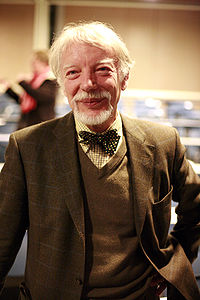|
Jan Assmann (Langelsheim, 7 de julho de 1938 – Constança, 19 de fevereiro de 2024)[1] foi um egiptólogo e teórico da cultura alemão, professor de egiptologia da Universidade de Heidelberg e de ciência da cultura da Universidade de Constança.
Vida e obras
Assmann estudou egiptologia e arqueologia clássica em Munique, Heidelberg, Paris e Göttingen. Em 1966-67, ele foi bolsista do Instituto Arqueológico Alemão no Cairo, onde continuou como acadêmico independente de 1967 a 1971. Após completar sua habilitação em 1971, ele foi nomeado professor de egiptologia na Universidade de Heidelberg em 1976, onde lecionou até se aposentar em 2003. Foi então nomeado Professor Honorário de Estudos Culturais da Universidade de Constança.[2][3]
Na década de 1990, Assmann e sua esposa Aleida Assmann desenvolveram uma teoria da memória cultural e comunicativa que recebeu muita atenção internacional. Ele também é conhecido além dos círculos Egiptologia por sua interpretação das origens do monoteísmo, que ele considera como uma ruptura de mais cedo cosmoteísmo, primeiro com ateísmo e mais tarde com o Êxodo do Egito dos israelitas.[4]
Escritos sobre religiões egípcias e outras
Assmann sugere que a antiga religião egípcia teve uma influência mais significativa no judaísmo do que geralmente se reconhece.[5] Ele usou o termo "inversão normativa" para sugerir que alguns aspectos do Judaísmo foram formulados em reação direta às práticas e teologia egípcias. Ele atribuiu o princípio da inversão normativa a um princípio estabelecido por Mâneton que foi usado por Maimonides em suas referências aos sabeus. Seu livro The Price of Monotheism recebeu algumas críticas por sua noção de The Mosaic Distinction.[6] Ele também não mantém mais essa teoria, pelo menos não em sua forma original (especificamente, o aspecto do mosaico).[7]
Publicações
- Re und Amun: Die Krise des polytheistischen Weltbilds im Ägypten der 18.-20. Dynastie (Orbis Biblicus et Orientalis 51). Fribourg e Göttingen 1983.
- Ägypten: Theologie und Frömmigkeit einer frühen Hochkultur (Urban-Bücherei, vol.366, Stuttgart 1984).
- The Search for God in Ancient Egypt trans. David Lorton (2001) ISBN 0-8014-8729-3
- "Maât: l'Égypte pharaonique et l'idée de justice sociale" in: Conférences, essais et leçons du Collège de France. Paris: Julliard, 1989.
- German: Ma`at: Gerechtigkeit und Unsterblichkeit im alten Ägypten. Munich 1990 (Tradução árabe 1996).
- Stein und Zeit: Mensch und Gesellschaft im Alten Ägypten. Munich 1991.
- Das kulturelle Gedächtnis: Schrift, Erinnerung und politische Identität in frühen Hochkulturen. Munich 1992. ISBN 3-406-36088-2 ASIN B001C84TR4
- trad.: Cultural Memory and Early Civilization: Writing, Remembrance, and Political Imagination. Cambridge University Press, 2011. ISBN 0-521-18802-4, ISBN 978-0-521-18802-9
- Monotheismus und Kosmotheismus (1993) ISBN 3-8253-0026-9
- Egyptian Solar Religion (Estudos em Egiptologia) (1995) ISBN 0-7103-0465-X
- Ägypten: Eine Sinngeschichte (Munich: Hanser 1996; Frankfurt: Fischer, 1999); trad. The Mind of Egypt: History and Meaning in the Time of the Pharaohs (New York: Metropolitan Books, 2002; Harvard University Press, 2003).
- Moses der Ägypter: Entzifferung einer Gedächtnisspur. Munich 1998.
- Moses the Egyptian: The Memory of Egypt in Western Monotheism (Cambridge, Mass.: Harvard University Press, 1997; 1998) ISBN 0-674-58739-1
- Religion and Cultural Memory: Ten Studies (Cultural Memory in the Present) trad. Rodney Livingstone, SUP (2005) ISBN 0-8047-4523-4
- Death And Salvation In Ancient Egypt, trad. David Lorton (2006) ISBN 0-8014-4241-9
- Altägyptische Totenliturgien, Bd.1, Totenliturgien in den Sargtexten (2002) ISBN 3-8253-1199-6
- Die Mosaische Unterscheidung oder der Preis des Monotheismus. Munich 2003.
- trad. Robert Savage: The Mosaic Distinction or The Price of Monotheism (SUP, 2009) ISBN 0-8047-6160-4
- Ägyptische Geheimnisse (2003) ISBN 3-7705-3687-8
- Theologie und Weisheit im alten Ägypten (2005) ISBN 3-7705-4069-7
- Die Zauberflöte (2005) ISBN 3-446-20673-6
- Thomas Mann und Ägypten: Mythos und Monotheismus in den Josephsromanen (Munich 2006).
- Monotheismus und die Sprache der Gewalt (2006) ISBN 3-85452-516-8
- Of God and Gods: Egypt, Israel, and the Rise of Monotheism (University of Wisconsin Press, 2008)
- From Akhenaten to Moses. Ancient Egypt and religious change (The American University in Cairo Press 2014).
- Exodus: Die Revolution der Alten Welt (Munich 2015) ISBN 978-3-406-67430-3
- Livros em inglês
Referências
- ↑ Rech, David (20 de fevereiro de 2024). «Kulturwissenschaftler: Jan Assmann ist tot». Die Zeit (em alemão). ISSN 0044-2070. Consultado em 21 de fevereiro de 2024
- ↑ «Unbenanntes Dokument». Consultado em 21 de setembro de 2014
- ↑ «Kurzvita Prof. Dr. Dr. h.c. Jan Assmann». Consultado em 21 de setembro de 2014
- ↑ Assmann, Jan. «Monotheism as Anti-Cosmotheism». The Price of Monotheism. [S.l.: s.n.]
- ↑ Jan Assmann, Moses The Egyptian: The Memory of Egypt In Western Monotheism (Harvard University Press, 1997). ISBN 978-0674020306
- ↑ The God Question: Jan Assmann's 'The Mosaic Distinction' and the Return of the Repressed in the "Post-Secular" Age Hollweck, Thomas. "The God Question: Jan Assmann's 'The Mosaic Distinction' and the Return of the Repressed" (Paper presented at the annual meeting of the American Political Science Association, Chicago, IL, Sep 2, 2004)
- ↑ Assmann, Jan (2015). «Exodus and Memory» (PDF). Israel's Exodus in Transdisciplinary Perspective: Text, Archaeology, Culture, and Geoscience. Quantitative Methods in the Humanities and Social Sciences: 3–15. ISBN 978-3-319-04767-6. doi:10.1007/978-3-319-04768-3_1.
In my book Moses the Egyptian, which I wrote in California 20 years ago, I tried to define the conceptual core of the Exodus narrative as the “Mosaic distinction” between true and false religion or true and false Gods (Assmann 1997; see also Assmann 2007, 2010). This theory has met with much criticism and I would not hold it any longer. The distinction as such, and as a defining feature of monotheism, still seems to me irrefutable, but I would no longer call it “mosaic.” It is true that the distinction between true and false in religion seems somehow implied in the prohibition of the worship of other gods and images, but it becomes a question of truth only later in antiquity with a certain concept of revelation... Ifthere is any “Mosaic distinction,” it is the distinction between matrimonial faithfulness and adultery, political loyalty and apostasy, filial love and rebellion, and, in this sense, between friend and foe, love and wrath.
Ligações externas
|

